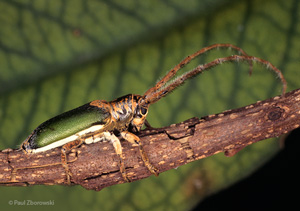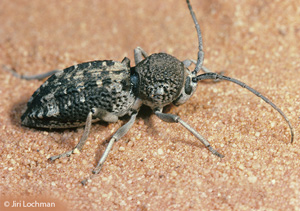The vast world literature on cerambycid biology has been reviewed by Duffy (1953, 1963), Linsley (1959, 1961) and Švacha and Lawrence (in press). The information published so far is heavily biased towards a few economically important pest species and/or to generally better known species from the Palaearctic and Nearctic Regions.
Various aspects of biology of the Australian species were described in numerous early papers, mostly by D. Best (1881–1920), A.R. Brimblecombe (1943–1956) and W.W. Froggatt (1893–1930). These were summarised by Duffy (1963) who has described numerous larvae and provided new biological insight based on larval collecting data and unpublished information from his collaborators.
Later contributions to the knowledge of biology of the Australian Cerambycidae include many papers on pollination and host plants by G.A. Webb (1985–1997) and T.J. Hawkeswood and their collaborators (1985–2011). Food preferences Cerambycidae are phytophagous beetles.
Their larvae, called round-headed borers, develop in tissues of woody or herbaceous plants in conditions ranging from healthy and alive to dead and decomposing due to fungi (Duffy 1953). In addition to the standard set of digestive enzymes, the gut of cerambycid larvae contains cellulotic enzymes and yeast-like symbionts (in the mid gut) help to extract sugars and critical particles like nitrogen from the wood material (Švacha & Lawrence, in press). Some Australian cerambycids apparently are specialists confined to a single or a few plant species suitable for larval development, but many show amazingly broad host ranges that include native and introduced gymnosperms and angiosperms (Duffy 1963; Hawkeswood & Dauber 1991).
Hanks (1999) classified cerambycids into four categories based on the condition of the larval host plant at the time of colonisation. The species that attack healthy and vigorous plants are able to develop in stems of herbaceous plants and in twigs of woody plants, often inducing gall-like structures on the host plants.
All serious pest species classified in Lamiinae (e.g. Anaplophora, Monochamus) belong to this first category. In addition, some Lamiinae girdle branches of their hosts before oviposition (Stride & Warwick 1962), or their larvae are able to girdle the branches or roots internally during feeding (Linsley 1961).
Many Lamiinae and Cerambycinae colonise the host that has been attacked previously by bark borers or has been weakened by poor growing conditions, fire or flood. These species often are able to complete several generations on an individual tree and only exceptionally kill the host. The species in the third category, are able to colonise woody plants that are severely stressed and dying because of intense fire, drought or attack by bark beetles or nematodes; these species are able to complete only one generation before killing the host. The dead wooden hosts, often also infested by fungi, are then available for many generations of cerambycid species of the fourth category that develop in dead hosts until they decompose and are no longer suitable for their larvae.

